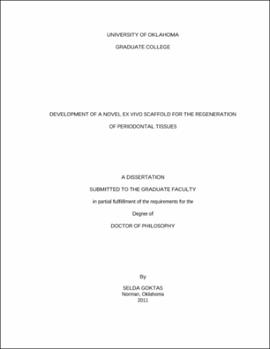| dc.contributor.advisor | Lobban, Lance L. | |
| dc.creator | Goktas, Selda | |
| dc.date.accessioned | 2019-04-27T21:26:35Z | |
| dc.date.available | 2019-04-27T21:26:35Z | |
| dc.date.issued | 2011 | |
| dc.identifier | 99197039402042 | |
| dc.identifier.uri | https://hdl.handle.net/11244/318693 | |
| dc.description.abstract | Burgeoning knowledge of the principles of tissue engineering has enabled periodontal surgeons to evolve from resective therapies to more regenerative approaches to treat the periodontal diseases that afflict a large portion of the population. These investigations describe the development of a novel 3D ex vivo scaffold derived from the Human Umbilical Vein (HUV) and its potential as an alternative surgical barrier material for the regeneration of periodontal tissues. | |
| dc.description.abstract | Periodontal grafting materials should fulfill several requirements, of which the mechanical matching of the scaffold with the native residual tissue is crucial. However, little attention has been given to understanding the biomechanical behavior of oral soft tissues, and this represents an obstacle for the development of biomaterials that perform with appropriate biomechanical characteristics. With this as our motivation, an in vitro uniaxial mechanical analysis was performed on mammalian oral soft tissue to further our understanding of these complex tissues. Porcine oral soft tissues from both lingual and buccal sites were assessed to gain insight into human tissue performance and site-specific mechanical variation. Mechanical analysis was conducted on 3 different regions of the oral tissues - namely, the attached gingiva, alveolar mucosa, and buccal mucosa. Our hypothesis stated that a discrete quantitative mechanical analysis describing zonal behavior of each soft tissue region would correlate with published qualitative data. Results confirm the keratinized gingiva to have increased tensile strength and stiffness relative to non-keratinized mucosal regions, where densely arranged elastin fibers contribute to a tissue with increased viscoelastic properties. These investigations quantify the biomechanical properties of these oral soft tissues and show region-to-region variation that provides important insight into structure-function relationships necessary to support masticatory and other oral forces. | |
| dc.description.abstract | Following the mechanical characterization of the porcine model system as reference, HUV were isolated from umbilical cords using a semi-automated machining technology, and decellularized using 1% sodium dodecyl sulphate (SDS). Uniaxial tensile testing, stress relaxation, and suture retention tests were performed on the acellular matrix to evaluate the HUV's biomechanical properties and human gingival fibroblasts (hGF) were seeded to assess adhesion, metabolic function and proliferation on the scaffold. Results show the scaffolds biomechanical properties were dependent upon the complex composition of the ex vivo scaffold, with the composite nature of the ex vivo tissue contributing to the biomechanical variability. Cell proliferation and metabolic activity were shown to be dependent upon the surface characteristics; in this case the lumen and ablumenal surfaces of the vascular derived scaffolds. hGF migration into the scaffold was also influenced by the organization of extracellular matrix (ECM) components, where the lumenal surface inhibits cell migration, acting as a barrier, whilst the ablumenal surface promotes cellular invasion. The results have shown the HUV bioscaffold with its unique biochemical and biomechanical properties represents a promising naturally derived surgical barrier for periodontal tissue regeneration. | |
| dc.description.abstract | In order to create functional HUV bioscaffolds for periodontal tissue engineering applications, in vitro 3D culture conditions were developed and optimized. The goal was to assess the scaffolds' capacity to initiate the regeneration processes while mimicking the physiological conditions. The HUV scaffold was decellularized according to our previously described protocol in order to remove the cellular components that may cause any immune reactions by the host. The human gingival fibroblast (hGF) cells were cultured on the HUV grafts under both static and dynamic conditions for 7 and 28 days. We hypothesized that the flow conditions would enhance the cellular biological activities towards the achievement of periodontal regeneration. The adherence, migration and proliferation capacities of hGFs were evaluated over time. Investigations were also conducted to test the gene expression profiles of the hGFs cultured on the HUV scaffold. The data presented in this study reveals the dynamic culture conditions enhance the attachment and migration of hGFs on the HUV tissue matrix, as visualized with histological and immunohistochemical analyses. The cellular metabolic activity, proliferation rate and gene expression profiling also supported our hypothesis for this study. | |
| dc.format.extent | 222 pages | |
| dc.format.medium | application.pdf | |
| dc.language | en_US | |
| dc.relation.requires | Adobe Acrobat Reader | |
| dc.subject | Guided tissue regeneration | |
| dc.subject | Vascular grafts | |
| dc.subject | Tissue engineering | |
| dc.subject | Periodontal disease--Treatment | |
| dc.title | Development of a Novel Ex Vivo Scaffold for the Regeneration of Periodontal Tissues | |
| dc.type | text | |
| dc.type | document | |
| dc.thesis.degree | Ph.D. | |
| ou.group | College of Engineering::School of Chemical, Biological and Materials Engineering | |
